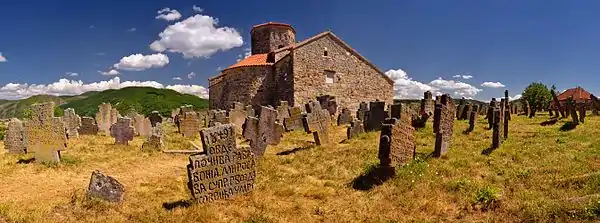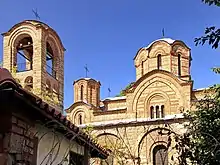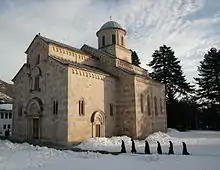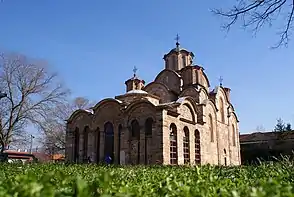Eparchy of Raška and Prizren
Eparchy of Raška and Prizren[lower-alpha 1] is one of the oldest eparchies of the Serbian Orthodox Church, featuring the seat of the Serbian Orthodox Church, the Serbian Patriarchal Monastery of Peć, as well as Serbian Orthodox Monastery of Visoki Dečani, which together are part of the UNESCO World Heritage sites of Serbia. More than 100 of the Eparchy's churches and monasteries were targeted for vandalism and destruction by Albanian nationalists after the Kosovo War and during the 2004 unrest in Kosovo.[1]
Eparchy of Raška-Prizren and Kosovo-Metohija Епархија рашко-призренска и косовско-метохијска | |
|---|---|
 | |
| Location | |
| Territory | Raška (Serbia), Kosovo |
| Headquarters | Prizren, Kosovo |
| Information | |
| Denomination | Eastern Orthodox |
| Sui iuris church | Serbian Orthodox Church Patriarchate of Peć (Serbia) |
| Established | 13th century |
| Language | Church Slavonic Serbian |
| Current leadership | |
| Bishop | Teodosije Šibalić |
| Map | |
-en.svg.png.webp) | |
| Website | |
| http://www.eparhija-prizren.com/en | |

Jurisdiction of the Eparchy is reflected in its name: it has diocesan jurisdiction over Eastern Orthodox Christians in historical regions of Raška (Serbia) and Kosovo and Metohija. The official see of the Eparchy is in Prizren, Kosovo.
History
Under the jurisdiction of Archbishopric of Justiniana Prima
Within the territory of the present-day Eparchy of Raška and Prizren several older eparchies existed throughout history. One of them was the ancient Bishopric of Ulpiana also known as Iustiniana Secunda situated near the modern town of Lipljan, where the remains of episcopal Basilica dating from the first half of 6th century have been found and excavated. Originally, the episcopal see of Ulpiana was under the supreme jurisdiction of the Archbishopric of Thessaloniki, and in 535 it was transferred to newly created Archbishopric of Justiniana Prima. Byzantine rule in that region collapsed at the beginning of the 7th century and the church life was later renewed after a more pronounced Christianization of Serbs.[2]
Episcopal sees in Serbian lands
The Bishopric of Ras was named after the old-Serbian-Bulgarian fortress of Ras that was situated near modern-day Novi Pazar. From the name of Ras the name of entire region was also derived (ser. Рашка (Raška), lat. Rascia).[3] The Bishopric of Ras emerged sometime during the 9th century, in the time that was marked by great missionary work of saints Cyril and Methodius and their disciples among Slavs, from Great Moravia in the north to Bulgaria in the east. During the rule of the prince Mutimir of Serbia and Byzantine emperor Basil I (867–886) process of Christianization of Serbs was finalized. One of Mutimirs sons was baptized as Stefan (Stefan Mutimirović) and other members of the ruling Serbian dynasty also received Christian names like princes Petar Gojniković, Pavle Branović and Zaharija Pribislavljević.[4]
Serbian bishopric of Ras was founded in the time of major ecclesiastical events that took place around the Council of Constantinople in 869–870 and the Council of Constantinople in 879–880.[5] Two land-marking decisions have been made in that time. First, the decision of the Patriarchate of Constantinople to create autonomous Archbishopric for Bulgaria after the Conversion of Bulgarians to Christianity and second, the decision of 870 that confirmed the attachment of Bulgarian Church to Eastern Orthodoxy.[6] By 878, episcopal sees in nearby cities of Belgrade and Braničevo have already been firmly established. It can be concluded that the Bishopric of Ras was also founded by that time. Close ties between Serbia and Byzantine Empire secured the communion of Serbian Church with the Eastern Orthodoxy and its main center in Constantinople, with one important distinction: Serbs adopted the use of Old Church Slavonic liturgy instead of Greek.
In the time of emperor John I Tzimiskes (969–976), Byzantine rule was restored in the region and protospatharios John was appointed as governor (catepan) of Ras.[7][8]
Under the jurisdiction of Archbishopric of Ohrid
.jpg.webp)
After the victorious Byzantine conquest of Bulgaria in 1018, by order of emperor Basil II an autonomous Bulgarian Archbishopric of Ohrid was established in 1019, by lowering the rank of the autocephalous Bulgarian Patriarchate due to its subjugation to Constantinople, placing it under the supreme ecclesiastical jurisdiction the Patriarchate of Constantinople. Imperial charters of 1019 and 1020 mention three bishoprics on the territory of present-day Eparchy of Raška and Prizren with episcopal seats in the cities of Ras, Prizren and Lipljan. All three were designated as distinct dioceses of the autonomous Archbishopric of Ohrid. Until the beginning of the 13th century, archbishops of Ohrid were regarded as Archbishopric of Justiniana Prima and all Bulgaria.[9]
Under the jurisdiction of Serbian Orthodox Church
The autocephaly of Serbian Orthodox Church was established in 1219 by Saint Sava, who was consecrated as first Serbian archbishop by the Byzantine patriarch residing at that time in Nicaea. Since then, all of the three old bishoprics of Raška, Prizren[10] and Lipljan were under the constant jurisdiction of Archbishop of Serbia. New Bishopric of Hvosno was also created in northern parts of the region of Metohija.[11] The see of Serbian archbishop was soon transferred from Monastery of Žiča to Peć in Metohija.[12]
In 1346, Serbian Archbishopric was raised to the rank of Patriarchate with its see remaining in Peć. At the same time the bishoprics of Prizren and Lipljan were raised by title to the rank of metropolitanates. Bishops of Lipljan kept under their jurisdiction the region of central Kosovo with Gračanica and Novo Brdo. Period from the beginning of 13 century to the end of 14 century was the golden age for Orthodox Church in the regions of Raška, Kosovo and Metohija with many monasteries and churches built by Serbian rulers and local Serbian nobility.

In the time of Turkish conquests, in the middle of the 15th century, Serbian Orthodox Church suffered great devastation. Regions of Raška, Kosovo and Metohija finally fell under Turkish rule around 1455. Serbian Patriarchate was renewed in 1557 by patriarch Makarije Sokolović.[13] In that time (16th–17th century) on the territory of modern Eparchy there were: Patriarchal see in Peć and five eparchies: Raška, Prizren, Lipljan, Vučitrn and Hvosno. of All of the regional sees in Raška, Kosovo and Metohija remained under constant jurisdiction of Serbian Patriarchate until its abolition in 1766.[14]
During that time, two major events tragically impacted Orthodox Church in the region. In the time of Austro-Turkish war (1683–1699) relations between Muslims and Christians in European provinces of Ottoman Empire were radicalized. As a result of Turkish oppression, destruction of Churches and Monasteries and violence against non-Muslim civilian population, Serbian Christians and their church leaders headed by Serbian Patriarch Arsenije III sided with Austrians in 1689 and again in 1737 under Serbian Patriarch Arsenije IV.[15] In the following punitive campaigns, Turkish forces conducted systematic atrocities against Christian population in Serbian regions, mainly in Metohija, Kosovo and Raška, resulting in Great Migrations of the Serbs.[16]
One of the consequences of devastation and depopulation in the regions of Kosovo and Metohija during Austro-Turkish wars was the reorganization of local Serbian eparchies. The old Eparchy of Lipljan (with Gračanica and Novo Brdo) was merged with the Eparchy of Prizren and they remained united to the present day.
Modern history

In 1766, the Serbian Patriarchate of Peć and all of its eparchies that were on territories under Ottoman rule were placed under the jurisdiction of the Ecumenical Patriarchate of Constantinople. That included both eparchies of Raška and Prizren. During the transfer of jurisdictions, Serbian patriarchal archeparchy of Peć was abolished, and its territory was added to the Eparchy of Prizren. In 1789, that eparchy was placed under administration of metropolitan Joanikije of Raška. In 1808, the eparchies of Raška and Prizren were officially merged into the current Eparchy of Raška and Prizren. In 1894, the region of Pljevlja was also added to this eparchy.[17] Turkish rule ended in 1912, and territory of eparchy was divided between Kingdom of Serbia and Kingdom of Montenegro. Prizren became part of the Kingdom of Serbia, and Peja became part of the Kingdom of Montenegro. Political division was followed by reorganization of church administration. In the Montenegrin part, a separated Eparchy of Peć was created. During the First World War (1914-1918) territories of both eparchies were occupied by the army of Austria-Hungary. After the re-annexation in 1918, new Kingdom of Yugoslavia was created, and included all territories of Serbia and Montenegro.[18] After the Serbian Patriarchate was renewed in 1920, Eparchy of Raška and Prizren was returned to the jurisdiction of the Serbian Orthodox Church. In 1931, Eparchy of Peć was reincorporated into the Eparchy of Raška and Prizren. In 1941, Yugoslavia was attacked and occupied by Nazi Germany and its allies.[19] The territory of the Eparchy of Raška and Prizren was occupied by Germans (northern part), Italians (central part) and Bulgarians (eastern part). The Italian occupation zone was annexed to the Italian protectorate of Albania. That marked the beginning of mass persecution of ethnic Serbs in the annexed regions of Metohija and central Kosovo. Many Serbian churches of the Eparchy of Raška and Prizren were looted and destroyed. Reign of terror was enforced by Albanian fascist organization Balli Kombëtar and by Albanian SS Division "Skanderbeg", created by Heinrich Himmler.[20] By the time of the re-annexation in 1944, the Serbian population, of which most were colonizers after the 1st Balkan War, were expelled from Kosovo.
Church buildings

Church of Saint Apostles Peter and Paul in Ras
The Church of Peter and Paul in Ras is one of the most important Serbian Christian monuments from the Middle Age period of Serbia. The church was declared a Monument of Culture of Exceptional Importance in 1979, and it is protected by Serbia. The church served as a seat of the Bishopric of Ras, named after near by medieval capital of Serbia. The present church (9th–10th century) has been built on several earlier churches of which remains have been well preserved. The foundation of the church, the massive columns, ground-plan and the octagonal tower which conceals an inner cupola are examples of the circular mausolean architectural type used after Emperor Constantine (306–312). Saint Sava (1175–1235), a Serbian prince, brother of the Serbian king Stefan Prvovenčani and the founder of the Serbian Orthodox Church was baptized in the church. Stefan Nemanja held the council that outlawed the Bogumils at the church. The remains of frescoes date from the 10th to the 13th century; some of them were repainted in the mid-13th century.[21]
Church of the Holy Apostles Peter and Paul, Suva Reka
Monasteries
| English | Serbian Cyrillic | Founded |
|---|---|---|
| In Kosovo | ||
| Saint Archangels Monastery | Манастир Свети Арханђели | 1343 |
| Banjska Monastery | Бањска | 1312 |
| Binač (Buzovik) Monastery | Бинач/Бузовик | 14th century |
| Our Lady of Ljeviš | Богородица Љевишка | 1307 |
| Budisavci Monastery | Будисавци | 14th century |
| Devič Monastery | Девич | 1434 |
| Dobra Voda Monastery | Добра вода | 14th century |
| Dolac Monastery | Долац | 14th century |
| Draganac Monastery | Драганац | 1381 |
| Duboki Potok Monastery | 14th century | |
| Globarica Monastery | Глобарица | 16th century |
| Gorioč Monastery | Гориоч | early 14th century |
| Grabovac Monastery | Грабовац | 14th century |
| Gračanica monastery | Грачаница | 1310 |
| Kmetovce Monastery | Кметовце | early 14th century |
| Mušutište Monastery | Мушутиште | early 14th century |
| Patriarchal Monastery of Peć | Манастир Пећка патријаршија | early 13th century |
| Saint Barbara Monastery | ||
| Saint Marko Koriški | Свети Марко Коришки | 1467 |
| Saint Uroš Monastery | Свети Урош | >1371 |
| Sokolica Monastery | Соколица | 14th century |
| Studenica Hvostanska | Студеница Хвостанска | early 13th century |
| Tamnica Monastery | Тамница | 14th century |
| Ubožac Monastery | Убожац | late 13th century |
| Visoki Dečani Monastery | Високи Дечани | 1327 |
| Vračevo Monastery | ||
| Zočište Monastery | Зочиште | before 1327 |
Bishops and Metropolitans


- Leontius (fl. 1123–1126)
- Cyril (fl. 1141–1143)
- Euthemius (fl. 1170)
- Callinicus (fl. 1196)
Early bishops of Prizren:
- Ioannis (12th century)
- Avramios (fl. 1204)
- Nicephoros (fl. 1216)
Under the jurisdiction of the Ecumenical Patriarchate of Constantinople 1766–1920
Metropolitans of Prizren, 1766–1808:
- Gavrilo (1766–1774)
- Sofronije (around 1780)
- Jevsevije (died 1789)
- Joanikije of Raška, administrator of Prizren (1789–1808)
Metropolitans of Raška and Prizren, since the unification of the two eparchies in 1808:
- Joanikije (1789–1818)
- Zaharija (1819–1830)
- Ananije (1830–1836)
- German (1836–1838)
- Sinesije (1838–1840)
- Ignjatije (1840–1849)
- Partenije (1849–1854)
- Melentije Spandonidis (1854–1895)
- Dionisije Petrović (1896–1900)
- Nićifor Perić (1901–1911)
- Gavrilo Dožić (1912–1920)
Since the restoration of the Serbian Patriarchate in 1920:
- Mihajlo Šiljak (1920–1928)
- Serafim Jovanović (1928–1945)
- Vladimir Rajić (1947–1956) admin. (1945–1947)
- Pavle Stojčević (1957–1990)
- Artemije Radosavljević (1991–2010)
- Atanasije Jevtić (2010) (admin.)
- Amfilohije Radović (2010) (admin.)
- Teodosije Šibalić (2010–)
Notes
- Serbian: Епархија рашко-призренска / Eparhija raško-prizrenska, Albanian: Eparkia Rashkë - Prizren. Also known as the Eparchy of Raška-Prizren and Kosovo-Metohija (Serbian: Епархија рашко-призренска и косовско-метохијска / Eparhija raško-prizrenska i kosovsko-metohijska; Albanian: Eparkia Rashkë - Prizren).
References
- Rakitić, Dušan (2014). "Envisaging a Legal Framework for Ensuring Sustainable Preservation of Holy Places with Regard to the Case of Kosovo and Metohia". In Ferrari, Silvio; Benzo, Andrea (eds.). Between Cultural Diversity and Common Heritage: Legal and Religious Perspectives on the Sacred Places of the Mediterranean. Farnham, England: Ashgate Publishing. p. 193. ISBN 978-1-47242-601-7.
- Curta 2001, p. 125, 130.
- Ćirković 2004, p. 29-33.
- Ćirković 2004, p. 16-17.
- Vlasto 1970, p. 67-68, 208–209.
- Zlatarski, History of the Bulgarian State during the Middle Ages, vol. 1, ch. 2, Sofia, 1971, p. 159
- Stephenson 2003, p. 42.
- Stephenson 2003a, p. 122.
- Bulić 2013, p. 221-222.
- Јањић 2013, p. 157-170.
- Јањић 2009, p. 183-194.
- Ćirković 2004, p. 40-43.
- Ćirković 2004, p. 135-137.
- Ćirković 2004, p. 177.
- Ćirković 2004, p. 144, 244.
- Pavlowitch 2002, p. 19-20.
- Ракочевић 1983, p. 279.
- Ćirković 2004, p. 252-253.
- Ćirković 2004, p. 268-269.
- Tomasevich 2001, p. 154.
- Ćirković 2004, p. 17, 21, 30.
Sources
- Базић, Миљојко М. (2007). Идентитет и културно наслеђе Срба. Београд: Научна КМД. ISBN 9788684153823.
- Bulić, Dejan (2013). "The Fortifications of the Late Antiquity and the Early Byzantine Period on the Later Territory of the South-Slavic Principalities, and their re-occupation". The World of the Slavs: Studies of the East, West and South Slavs: Civitas, Oppidas, Villas and Archeological Evidence (7th to 11th Centuries AD). Istorijski institut SANU. pp. 137–234. ISBN 9788677431044.
- Čanak-Medić, Milka; Todić, Branislav (2017). The Monastery of the Patriarchate of Peć. Novi Sad: Platoneum, Beseda.
- Ćirković, Sima (2004). The Serbs. Malden: Blackwell Publishing. ISBN 9781405142915.
- Curta, Florin (2001). The Making of the Slavs: History and Archaeology of the Lower Danube Region, c. 500–700. Cambridge: Cambridge University Press. ISBN 9781139428880.
- Curta, Florin (2006). Southeastern Europe in the Middle Ages, 500–1250. Cambridge: Cambridge University Press.
- Đorđević, Života; Pejić, Svetlana, eds. (1999). Cultural Heritage of Kosovo and Metohija. Belgrade: Institute for the Protection of Cultural Monuments of the Republic of Serbia. ISBN 9788680879161.
- Ђурић, Војислав Ј.; Ћирковић, Сима; Кораћ, Војислав (1990). Пећка патријаршија. Београд-Приштина: Југословенска ревија, Јединство. ISBN 9788674130575.
- Ferrari, Silvio; Benzo, Andrea (2014). Between Cultural Diversity and Common Heritage: Legal and Religious Perspectives on the Sacred Places of the Mediterranean. London & New York: Routledge. ISBN 9781317175032.
- Fotić, Aleksandar (2008). "Serbian Orthodox Church". Encyclopedia of the Ottoman Empire. New York: Infobase Publishing. pp. 519–520. ISBN 9781438110257.
- Грујић, Радослав (1993). Азбучник Српске православне цркве. Београд: БИГЗ, Музеј СПЦ. ISBN 9788613006886.
- Јанковић, Марија (1985). Епископије и митрополије Српске цркве у средњем веку (Bishoprics and Metropolitanates of Serbian Church in Middle Ages). Београд: Историјски институт САНУ.
- Јањић, Драгана (2009). "Подаци за историју Хвостанске епархије (The Data for the History of Hvostan's Eparchy)" (PDF). Баштина (26): 183–194.
- Јањић, Драгана (2013). "Призренска епископија: Историјско-канонски аспекти (Prizren's diocese: Historical-canonical aspects)" (PDF). Баштина (34): 157–170.
- Kalić, Jovanka (1995). "Rascia – The Nucleus of the Medieval Serbian State". Faculty of Geography. Archived from the original on 15 January 2014. Retrieved 15 June 2016.
- Kia, Mehrdad (2011). Daily Life in the Ottoman Empire. Santa Barbara, California: Greenwood Press. ISBN 9780313064029.
- Коматина, Ивана (2016). Црква и држава у српским земљама од XI до XIII века. Београд: Историјски институт. ISBN 9788677431136.
- Krstić, Branislav (2003). Saving the Cultural Heritage of Serbia and Europe in Kosovo and Metohia. Belgrade: Coordination Center of the Federal Government and the Government of the Republic of Serbia for Kosovo and Metohia. ISBN 9788675560173.
- Ljubinković, Radivoje (1975). The Church of the Apostles in the Patriarchate of Peć. Belgrade: Jugoslavija.
- McAllester, Matthew (2001). Beyond the Mountains of the Damned: The War Inside Kosovo. New York-London: New York University Press. ISBN 9780814756614.
- Мијовић, Павле (1960). Пећка Патријаршија. Београд: Туристичка штампа.
- Милеуснић, Слободан (2007). Водич кроз манастире у Србији. Београд: МСТ Гајић, Завод за унапређивање образовања и васпитања. ISBN 9788682021162.
- Pavlovich, Paul (1989). The History of the Serbian Orthodox Church. Serbian Heritage Books. ISBN 9780969133124.
- Pavlowitch, Stevan K. (2002). Serbia: The History behind the Name. London: Hurst & Company. ISBN 9781850654773.
- Petković, Sreten (1982). The Patriarchate of Peć. Belgrade: Serbian Patriarchate.
- Popović, Svetlana (2002). "The Serbian Episcopal sees in the thirteenth century (Српска епископска седишта у XIII веку)". Старинар (51: 2001): 171–184.
- Ракочевић, Новица (1983). "Политичке и друштвене прилике". Историја српског народа. Vol. књ. 6, св. 1. Београд: Српска књижевна задруга. pp. 263–290.
- Слијепчевић, Ђоко М. (1962). Историја Српске православне цркве (History of the Serbian Orthodox Church). Vol. књ. 1. Минхен: Искра.
- Stephenson, Paul (2000). Byzantium's Balkan Frontier: A Political Study of the Northern Balkans, 900–1204. Cambridge: Cambridge University Press. ISBN 9780521770170.
- Stephenson, Paul (2003). The Legend of Basil the Bulgar-slayer. Cambridge University Press. ISBN 9780521815307.
- Stephenson, Paul (2003a). "The Balkan Frontier in the Year 1000". Byzantium in the year 1000. BRILL. pp. 109–134. ISBN 9004120971.
- Subotić, Gojko (1998). Art of Kosovo: The Sacred Land. New York: The Monacelli Press. ISBN 9781580930062.
- Todić, Branislav (1999). Serbian Medieval Painting: The Age of King Milutin. Belgrade: Draganić. ISBN 9788644102717.
- Tomasevich, Jozo (2001). War and Revolution in Yugoslavia, 1941–1945: Occupation and Collaboration. Vol. 2. San Francisco: Stanford University Press. ISBN 9780804779241.
- Vlasto, Alexis P. (1970). The entry of the Slavs into Christendom. Cambridge University Press. ISBN 9780521074599.
- Вуковић, Сава (1996). Српски јерарси од деветог до двадесетог века (Serbian Hierarchs from the 9th to the 20th Century). Евро, Унирекс, Каленић.
- Warrander, Gail; Knaus, Verena (2010). Kosovo (2nd ed.). Bradt Travel Guides. ISBN 9781841623313.
- Зиројевић, Олга (1984). Цркве и манастири на подручју Пећке патријаршије до 1683. године. Београд: Историјски институт, Народна књига.
- Živković, Tibor; Bojanin, Stanoje; Petrović, Vladeta, eds. (2000). Selected Charters of Serbian Rulers (XII-XV Century): Relating to the Territory of Kosovo and Metohia. Athens: Center for Studies of Byzantine Civilisation.
- Живковић, Тибор (2000). Словени и Ромеји: Славизација на простору Србије од VII до XI века (The Slavs and the Romans). Београд: Историјски институт САНУ, Службени гласник. ISBN 9788677430221.
- Живковић, Тибор (2002). Јужни Словени под византијском влашћу 600-1025 (South Slavs under the Byzantine Rule 600-1025). Београд: Историјски институт САНУ, Службени гласник. ISBN 9788677430276.
- Живковић, Тибор (2004). Црквена организација у српским земљама: Рани средњи век (Organization of the Church in Serbian Lands: Early Middle Ages). Београд: Историјски институт САНУ, Службени гласник. ISBN 9788677430443.
- Živković, Tibor (2008). Forging unity: The South Slavs between East and West 550-1150. Belgrade: The Institute of History, Čigoja štampa. ISBN 9788675585732.
- See Corridors
Further reading
- Crucified Kosovo: Destroyed and desecrated Serbian Orthodox churches in Kosovo and Metohia (June–October 1999)
- Jovanka Kalić, Rascia – The Nucleus of the Medieval Serbian State
- Sima Ćirković, Rises and falls in Serbian statehood in the Middle Ages
- Đorđe Janković, Kosovo And Metohia In The Middle Ages – Archaeological Research
- Radoš Ljušić, The centuries under Turkish rule and the revival of Serbian statehood
- Milovan Radovanović Kosovo and Metohia – A Geographical and Ethnocultural Entity in the Republic of Serbia
- Dušan Bataković, The Kosovo Chronicles
- Old Serbia and Albanians
External links
- Official site of the Eparchy of Raška and Prizren
- Official site of the Serbian Orthodox Church
- List of Cultural Monuments in Serbia
- Project Rastko: Kosovo and Metohija
- Monasteries of the Eparchy of Raška and Prizren
- Kosovo.net Serbian Orthodox Church in Kosovo and Metohia
- Теодосије нови епископ рашко-призренски („Политика“, 18. новембар 2010)
- Устоличење новоизабраног Епископа рашко-призренског Теодосија – Призрен,, 26. децембар 2010.








